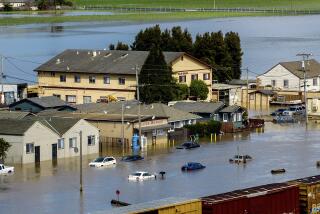After Dolly, the water rises
- Share via
CAPISALLO PARK COLONIA, TEXAS — After a night of anxious pacing, when it seemed like Hurricane Dolly had decided to park and pelt them with rain, the Guevara family went to bed thinking the worst was over.
They awoke at 5 a.m. Thursday, startled by an unusual rumbling sound, to find a river raging around their light blue cottage. The water kept rising.
“I couldn’t go back to sleep,” Elvia Guevara, 43, said in Spanish. “I was so worried it was about to come inside.”
The water stopped just inches beneath their porch, but the lawn became a lake when an overwhelmed drainage ditch flooded their ramshackle neighborhood in Hidalgo County.
So the Guevara family, five in all, just sat together on their porch Thursday and stared at the caramel-colored water, waiting for it to drop. There was nothing else to do.
Buster, a white dog with a black ring around his eye that made him look like Pete the Pup from “The Little Rascals,” was sitting on the roof of his doghouse, howling. It was barely above water. On the porch, their other pooch, Blacky Boy, a tiny runt with more than a hint of Chihuahua heritage, was whimpering. He’d had to swim to safety.
To the side of the house, a white horse named El Palomino was splashing around in his flooded pen. The top of a large trampoline was barely sticking out of the water on the front lawn. In the back, a lush palo blanco tree lay toppled on its side. It had crashed down overnight.
“We knew this hurricane could be bad,” said Jesus Guevara, 44, as ants crawled through the cracks in the porch, right beside his boots. “But we had no idea it could be so monstrous.”
Truth be told, Dolly -- which made landfall Wednesday as a Category 2 hurricane with winds topping 100 mph -- could have been much worse. The storm mangled hotels and apartment buildings on South Padre Island, but did only moderate damage elsewhere. No one was killed and few serious injuries were reported -- though more than 160,000 Texas residents were still without power as of Thursday afternoon.
President Bush declared 15 southern Texas counties disaster areas Thursday, opening the door for local officials to seek federal recovery assistance.
Authorities had been particularly worried that the slow-moving storm, which dumped well over a foot of water in several southern Texas counties before fading west into Mexico, would lead to levee breaks along the Rio Grande. That’s what happened in 1967, when Hurricane Beulah roared up the river’s mouth and killed 58 people.
The levees held this time, but many colonias -- shantytowns that have been built up along the border, often without proper sewers, drains and building permits -- experienced flooding.
Authorities had to help more than 60 people escape rising waters in Cameron County, the coastal region where the storm first hit. There were no rescues in Capisallo Park, west of the county line, where about 80 small houses -- from sturdy wood bungalows to corrugated metal shacks -- stood in pools of water. But many families who had fled navigated the downed power lines and flooded fields of corn and sorghum Thursday morning to find they could not even get close to their front doors.
Sheriffs deputies circled through the neighborhood and kept driving. One family trudged through the mud, carrying plastic bags full of supplies, after walking several miles to a Wal-Mart.
With much of the Rio Grande Valley soaked, Jesus Guevara stayed away from his job as a construction worker, and Elvia from hers cleaning at a healthcare clinic. Their children, Clarissa, 8, Merejilda, 11, and Eric, 17, were fidgeting on the porch.
Jesus said he had not seen anything like this since they moved in 10 years ago.
“I got so scared,” Merejilda said as her dad gently rapped her for touching the water with her toes. “I just kept looking at that water, saying, ‘Please don’t come up any higher.’ ”
Her mother was still surprised that it hadn’t.
“Gracias a Dios, se paro,” Elvia Guevara said. Thank God it stopped.
--
More to Read
Sign up for Essential California
The most important California stories and recommendations in your inbox every morning.
You may occasionally receive promotional content from the Los Angeles Times.










